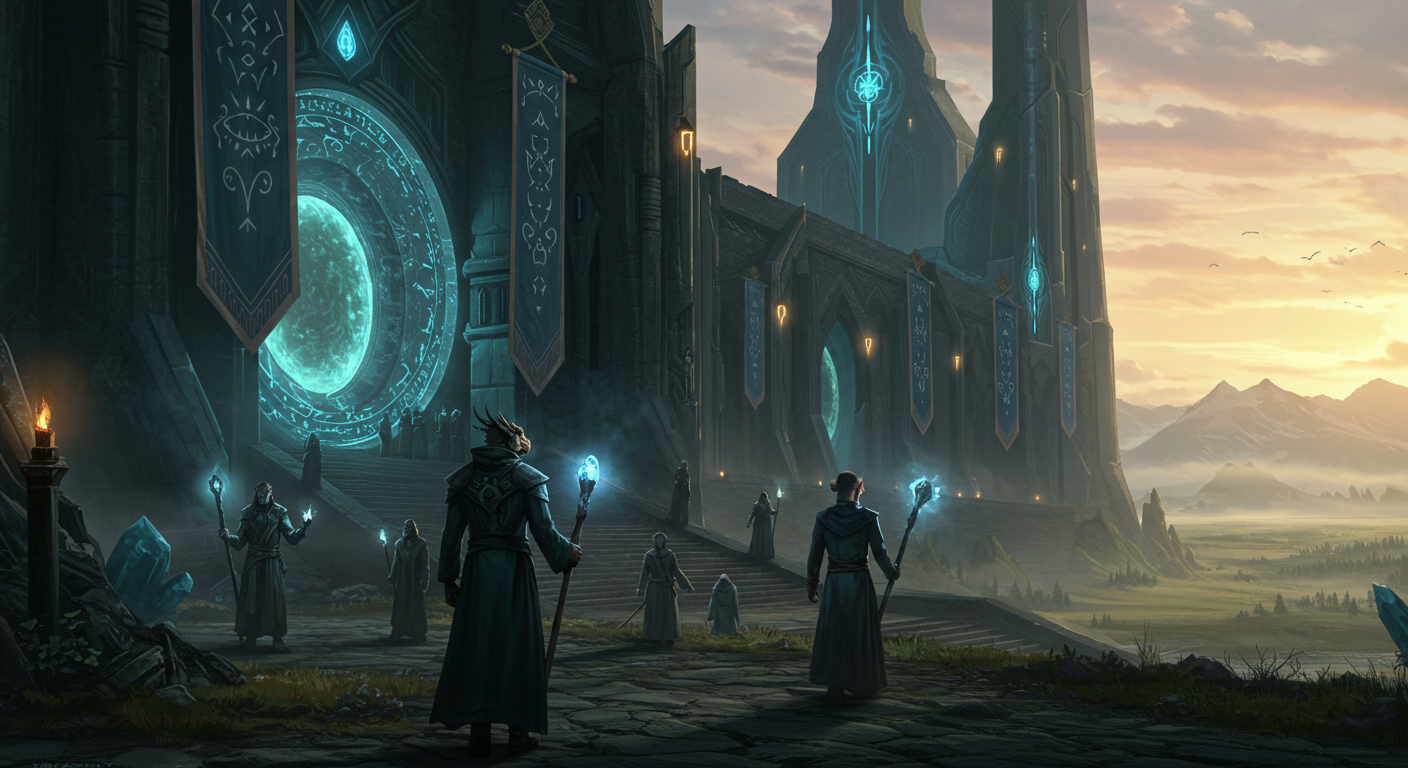Mages Guild
The Mages Guild stands as one of the most influential organizations in Azurythos, a beacon of arcane mastery and intellectual advancement. Formed in the aftermath of the Age of Demons, the guild was established to unite magic users across species and continents under a single banner of cooperation and regulation. Over the centuries, it has grown into a vast network of interconnected chapters, research institutions, and magical academies, influencing nearly every facet of life across the world.
Primary Goals and Aspirations
The Mages Guild’s overarching mission is threefold: to preserve, advance, and regulate the use of magic in Azurythos.
- Preservation: The guild tirelessly archives ancient knowledge, safeguarding scrolls, tomes, and artifacts from a bygone age. The Guild’s central archives are said to rival even the libraries of the Dragonborn. These repositories of wisdom are not merely for posterity; they are tools for understanding and controlling the forces of the arcane.
- Advancement: Through rigorous experimentation, collaboration, and innovation, the guild pushes the boundaries of what magic can achieve. Projects range from developing more efficient methods of communication across continents to delving into planar magic and the secrets of the Abyss itself.
- Regulation: To prevent misuse of arcane power, the guild enforces strict ethical codes and monitors the use of high-level spells. Unauthorized use of dangerous magic can result in severe penalties, including expulsion or imprisonment. Rogue spellcasters are a constant concern, and local chapters are tasked with identifying and neutralizing such threats.
Structure and Organization
The guild operates under a hierarchical system, with each local chapter enjoying a degree of autonomy while adhering to the directives of the Grand Arcane Council. The council, based on the island of Tharilos, governs the guild's global policies, research priorities, and enforcement mechanisms. Each chapter is led by a Guildmaster who coordinates local operations and serves as a liaison to the council.
Chapters are typically established in settlements with a population of 5,000 or more. Smaller outposts exist in remote areas, often staffed by a single mage or apprentice tasked with monitoring regional activity and providing magical assistance to isolated communities.
The guild also operates specialized facilities, such as research enclaves, magical forges, and teleportation hubs. These centers are integral to the guild’s mission, serving as places of study and innovation while facilitating global communication and trade.
Methods of Achieving Their Goals
- Education and Training: The guild provides comprehensive training for aspiring mages, with each chapter offering apprenticeships, lectures, and practical instruction. Graduates of these programs are expected to abide by the guild’s ethical standards and contribute to its goals.
- Research Initiatives: Collaborative projects are a hallmark of the guild. Researchers from diverse magical disciplines work together to solve pressing issues, such as refining protective spells for settlements in demon-threatened regions or developing new means of magical transportation.
- Public Services: Local chapters offer services such as magical healing, weather control, and the crafting of enchanted items. These services generate revenue for the guild while ensuring its value to the broader community.
- Monitoring and Enforcement: To maintain order, the guild employs Arcane Sentinels—mages trained in combat and investigative techniques. These enforcers are responsible for tracking down rogue spellcasters and responding to magical threats.
- Advisory Roles: Many of Azurythos’s rulers rely on guild-trained mages as advisors or court wizards. This ensures the guild's voice is present in political decisions, particularly those involving magic.
Global Influence and Perception
The guild’s pervasive presence has made it both revered and resented. Among common folk, the guild is often seen as a force for stability, capable of solving problems beyond mortal means. Merchants and nobles rely heavily on the guild’s communication networks, magical protections, and economic contributions. However, some view the guild as a shadowy power broker, its influence extending far beyond its stated mission.
In regions like Tharkalos, where Dragonborn traditions hold sway, the guild’s authority is respected but kept at arm’s length. The Dragonborn prefer to maintain their own arcane practices, and some see the guild’s regulatory efforts as an affront to their independence. Conversely, in human-dominated regions, the guild often functions as an essential part of society, its magic integrated into daily life.
Reactions to the Arrival of Earthlings
The sudden appearance of humans from Earth presents a unique challenge and opportunity for the Mages Guild. At the local chapter level, reactions would vary widely based on regional culture and leadership. In conservative or isolationist areas, Earthlings might be viewed with suspicion or hostility, especially if their presence disrupts local order. In more progressive chapters, curiosity and eagerness to learn from these outsiders would dominate.
The Grand Arcane Council would take a measured approach, initially treating the Earthlings as a potential resource to be studied. Their knowledge of Earth science, history, and technology could provide new perspectives on magical theory, though the council would carefully monitor their integration to prevent societal upheaval.
Should Earthlings demonstrate magical aptitude, the guild would likely offer training programs tailored to their needs, albeit with an ulterior motive: ensuring their abilities are used in ways that benefit the guild. Earthlings who resist or operate outside guild oversight could find themselves targeted by Arcane Sentinels.
Conclusion
The Mages Guild is a cornerstone of Azurythos, shaping the magical and political landscapes through its unparalleled resources and influence. While its public mission is one of unity and advancement, its hidden ties to the Academy of Unified Scales hint at deeper ambitions. As the world grapples with the mysteries of the Abyss and the arrival of Earthlings, the guild’s role is set to become even more pivotal, for better or worse.
Structure
The Mages Guild is a hierarchical organization with a clear chain of command:
- Archmagus Supreme: Global leader, directs policy and global priorities.
- Regional Magi Councils: Governing bodies for continents or large regions.
- Chapter Masters: Leaders of individual guild halls in major cities or regions.
- Guild Members: Includes apprentices, journeymen, and masters.
Culture
The guild values knowledge, collaboration, and order. Members are expected to prioritize the ethical use of magic, but their loyalty to the guild supersedes national or local allegiances. This creates tension between mages and local authorities in some regions.
Public Agenda
Promote the safe use of magic.
Serve as a neutral body for arcane education and research.
Mediate magical disputes and regulate spellcaster activities.
Protect the world from magical threats.
Assets
Extensive libraries and arcane laboratories.
Guild halls in nearly every major city.
A fleet of magically-enhanced airships for transport and defense.
The Arcanum Tower and hidden facilities tied to the Academy.
History
The guild was formed during the Age of Demons when rogue spellcasters wreaked havoc. The Circle of Eight unified the world’s mages, creating the guild to stabilize magic use and protect civilization. Over centuries, the guild grew into a global power, influencing politics, trade, and innovation while hiding its ties to the Academy.
Territories
The Mages Guild claims no sovereign territory outside of Tharilos, where it holds exclusive jurisdiction. Its influence is pervasive across other regions, with guild halls serving as semi-autonomous zones under guild law.
Military
The guild lacks a traditional army but maintains several defensive forces:
- Arcane Wardens: Skilled mages tasked with protecting guild interests and enforcing laws.
- Elemental Constructs: Magically created guardians stationed at major guild halls.
- Battlemages: Trained combat spellcasters who assist in regional crises.
In emergencies, the guild may conscript local members or collaborate with the Adventurers Guild to address threats.
Technological Level
The guild represents the pinnacle of magical and technological integration in Azurythos. Notable advancements include:
- Elemental Energy Harnessing: Powering cities and facilities with bound elementals.
- Arcane Constructs: Golems and automatons used for labor and defense.
- Spellweaving Techniques: Creating permanent magical effects for practical and military use.
Foreign Relations
The guild maintains a careful balance of neutrality, striving to serve all nations and species equally.
- Relations with the Dragonborn: Strong ties due to their role in founding the Academy. However, some younger Dragonborn question the guild’s impartiality.
- Relations with Humans: Cooperative in regions where humans dominate, though some human rulers distrust the guild’s influence.
- Relations with Gnolls and Goblins: Often strained due to the guild’s focus on stability, which can conflict with these species’ decentralized structures.
- Relations with Tieflings: Cautious but willing to engage. The guild monitors Tiefling activities closely due to potential Abyssal ties.
Laws
The guild operates under strict internal regulations, many of which are hidden from public view:
- Code of Arcane Ethics: Prohibits reckless or destructive magic use, with penalties ranging from expulsion to imprisonment.
- Registration of Spellcasters: Requires all mages to register with the guild or risk being branded as rogue spellcasters.
- Neutrality Mandate: Members are forbidden from using guild resources to support political or military conflicts without express approval.
Enforcement: The guild employs Arcane Wardens, spellcasters trained to investigate and enforce guild laws. Punishments range from fines to imprisonment in magically secured cells.
Agriculture & Industry
The guild relies on magical agriculture and aquaculture on Tharilos to sustain its population. Enchanted greenhouses, water purification systems, and elementally-powered mills ensure a steady food supply.
Trade & Transport
The guild operates a sophisticated network of magical transportation, including teleportation circles and enchanted airships. It trades:
- Imports: Rare magical reagents and tomes from across Azurythos.
- Exports: Magical artifacts, potions, and enchanted items to support guild operations.
Education
All guild members undergo rigorous training, beginning with apprenticeships that can last years. The educational structure includes:
- Initiate Training: Basic spellcasting and ethics.
- Journeyman Path: Specialization in a magical discipline.
- Mastery Trials: Rigorous tests to achieve the rank of Master.
Access to higher education is merit-based, but noble families often use political leverage to secure placements for their children.
Infrastructure
Teleportation Circles: Connect major guild halls for swift travel.
Enchanted Libraries: Automatically organize and preserve texts.
Elemental Foundries: Forge magical artifacts and tools.
Scrying Networks: Used for global communication and surveillance.

"To Illuminate, Preserve, and Advance the Arcane."
The Mages Guild operates numerous guild halls, training facilities, and outposts across Azurythos. These include:
- The Arcanum Tower (Headquarters): Located on Tharilos, serving as the central hub for guild operations and training.
- Regional Guild Halls: Found in major cities like Kravyrak, Velokar (Dragonborn), and Arathas (human territories).
- Arcane Outposts: Small facilities in remote or dangerous regions, offering aid to travelers and maintaining magical stability.
- Secret Research Sites: Hidden facilities for sensitive research tied to the Academy.



Comments